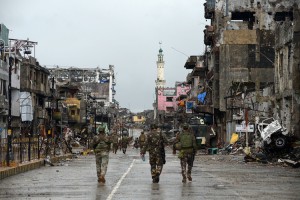The Fight for Marawi City
Tuesday, October 24th, 2017October 24, 2017
Yesterday, October 23, the Philippine military announced the end of a bloody five-month campaign to oust Abu Sayyaf and Maute Islamic rebels from Marawi City on the southern Philippine island of Mindanao. Filipino soldiers had been clearing the last rebels from the battered city since President Rodrigo Duterte declared Marawi “liberated from terrorist influence” on October 17. Duterte’s declaration came the day after the killing of the rebels’ main leaders, Isnilon Hapilon and Omarkhayam Maute. The Abu Sayyaf and Maute groups both have close ties to the Islamic State terror organization.

Filipino soldiers walk through the ruins of Marawi City on Oct. 17, 2017, the day President Rodrigo Duterte declared the city liberated from Islamic militant rebels. Credit: © Ted Aljibe, AFP/Getty Images
Marawi is the capital and only city in the province of Lanao del Sur on Mindanao. The city, officially known as the Islamic City of Marawi, and surrounding province have long been home to a significant Muslim community (most Filipinos are Roman Catholic). Marawi’s religious roots go back some 500 years, when the area was part of a sultanate linked to Islamic areas in nearby Indonesia and Malaysia.
Marawi, a city of 200,000 people, and Lanao del Sur are part of the Autonomous Region in Muslim Mindanao, the nation’s only self-governing region. However, Abu Sayyaf, meaning father of the swordsman in Arabic, has been in conflict with the national government since 1991 when it was part of an armed movement vying for complete independence. Abu Sayyaf has fought pitched battles against Philippine soldiers, and the group is notorious for bombings, kidnappings, and high-profile executions.
In late May 2017, Philippine security forces tried to capture Hapilon, the Abu Sayyaf leader, in Marawi, and a protracted gun battle erupted with Hapilon’s followers. Allying with the Maute group, a newer Islamic armed faction fed by extremists from Indonesia, Malaysia, and Singapore, Abu Sayyaf seized control of government buildings and other key points in Marawi. President Duterte responded by ordering a full-scale military campaign to reclaim Marawi from the Islamic rebels. He later declared martial law in all Mindanao.
Fighting began immediately as Philippine troops arrived to retake the city, which was emptied of its civilian population by mass evacuations. Street fighting slowly went the government’s way as air strikes pulverized rebel positions—along with much of the city. Block by block, rebels were rooted out and killed or captured. As rebel control shrank to a few isolated buildings, government troops finally cornered Hapilon, along with Maute, and killed them both in a gunfight on October 16. A week later, the military announced the end of 154 days of fighting that killed more than 900 rebels and some 300 troops and civilians.
The rebel hold on Marawi has ended, but much of the city is in ruins, and both the Abu Sayyaf and Maute groups maintain a strong following in much of Lanao del Sur. The long fight against Islamic rebels in Mindanao may be long from over.


